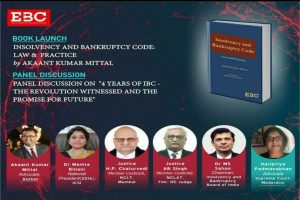After a brief introduction, Ms Padmanabhan proceeded to ask Justice Singh whether in his extensive experience as a judge of the High Court where he would have had an occasion to decide winding up cases, compared to his present office as Member of the NCLAT, does he think, that the IBC has made the process of insolvency more efficient? Listen to his answer below
To Dr Sahoo, Ms Padmanabhan asked whether that as new cases are time bound as they come under the new code, shouldn’t we consider transferring the existing winding up cases from HC to NCLT and NCLAT? She also asked his opinion on the fact that the Code was brought in to save businesses, however it has been found that more than half the cases which are closed under the Code ended up in Liquidation and only 14.93% of the cases ended up with a Resolution Plan. Why does he think this is the case? Dr Sahoo’s reply to the question can be seen below. Kindly pardon Dr Sahoo’s video quality because of connectivity issues.
Next Ms Padmanabhan asked Dr Binani that by the time companies reach NCLT they are very sick, the amount of time available for resolution should increase or decrease depending on what is at stake? Also, What does she think are some of the biggest challenges that a Resolution Professional faces under the Code? To see Dr Binani’s reply, watch the video below.
Ms Padmanabhan next addressed the author, Mr Mittal and asked him his opinion on the recent Supreme Court’s judgment with respect to the limitation act being applied to IBC. His answer can be seen below.
In the second round, Ms Padmanabhan proceeded to ask each panelist what measures can be introduced to make IBC more effective. See the video below for Justice Singh’s reply.
Listen to Dr Sahoo answer Justice AB Singh’s question on prepackaged insolvency and Ms Padmanabhan’s question on group insolvency and how to make IBC better. Kindly pardon the bad audio because of connectivity issues.
Ms Padmanabhan asked Dr Binani whether foreign portfolio investors are permitted to rescue companies under current IBC, the need to create a fund to facilitate the process and how to make the IBC better.
Ms Padmanabhan commented that Mr Mittal’s book contains many reports on the basis of which IBC was evolved. She asked him whether he thinks there are any lacunas in the law which can be addressed. See the video below for Mr Mittal’s reply.
Dr Padmanabhan finally ended the panel discussion by stating that the new law on insolvency has been a resounding success both in terms of reduction of time and recovery of dues and that she is very optimistic about the future of IBC. The webinar concluded with a vote of thanks to all panelists and all the people who contributed to the book in any small or big way.
The book can be bought here.
Nilufer Bhateja, Associate Editor has put this story together

